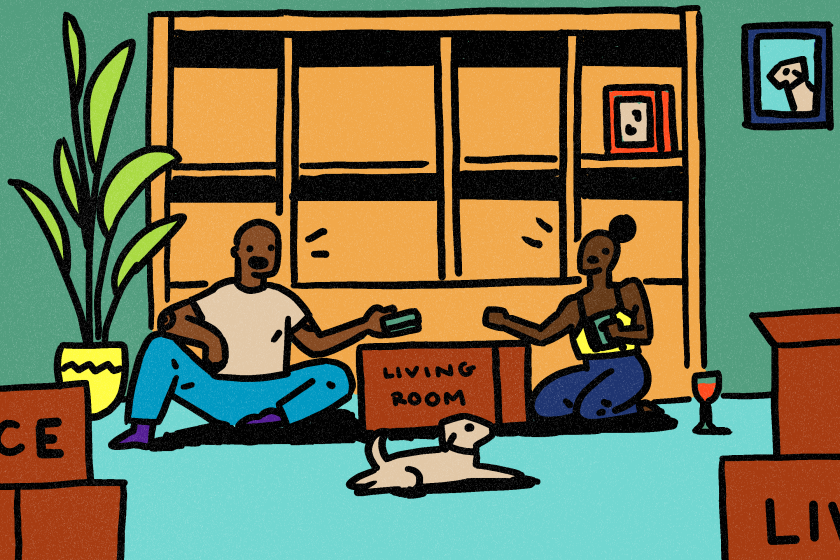Pets and rental housing: What you need to know

Did you get yourself a furry quarantine buddy? Well, you’re not the only one.
Adoptions, fosters and sales of pets soared during the early days of the COVID-19 shutdown. Instead of spring showers, it seemed to rain cats and dogs. And it is not surprising, given pets are excellent companions that can boost your mood and overall sense of well-being. Even the Centers for Disease Control and Prevention recognizes there are a multitude of ways pets can have a positive impact on your health.
From decreased loneliness to the increased opportunity for exercise, having a pet, especially during the pandemic, can feel like a saving grace.
One downside of pet ownership is the stressful task of finding your dream rental housing that allows your four-legged friends. Sadly, according to the Humane Society, one of the main reasons pets are given up to animal shelters is because of housing problems.
So, from one animal lover to another, here’s everything you need to know about rentals and having pets in Southern California.
How to find pet-friendly housing
First and foremost, give yourself plenty of time to search for your pet-friendly rental. Having to rush will only increase your stress level. A good starting point is to check ads and get in touch with local real estate agents and rental agencies to help you home in on properties you’re interested in.
The majority of online apartment/housing listing websites, such as Apartments.com, Westside Rentals, Zillow, Apartment List, Hotpads, Apartment Finder and RentCafe, have pet filters so you can easily search for pet-friendly units in your desired area and price range. The Humane Society and local animal care and control agencies also have resources and guides on L.A.-area housing that is considered pet-friendly.
Take note that rental properties might stipulate certain breeds of dog are not allowed or limited by weight. Call the property manager for details on a building’s pet policy.
Once you’ve found listings you are interested in, even if they are not explicitly listed as pet-friendly, you can draft a pet resume to show pet-averse landlords how great your pet is and why they deserve to live on-site. A pet resume is similar to a resume you would create when applying for a job. On the resume you can highlight your pet’s best qualities, personality, training level, references and health and vaccination history. Sending in a pet resume along with offering to set up an in-person meeting between the landlord and pet will allow the landlord to get to know your pet. Showing you are a trustworthy and proactive pet owner will put the best foot (or paw) forward.
It could be worth noting to a hesitant landlord the unique advantages of pet-friendly housing. A 2019 Healthy Pets Healthy Families Coalition report indicated that 2.9 million renters in L.A. were pet owners, and with pet ownership on the rise among renters, the coalition posits that increasing the number of pet-friendly rental units could bring a myriad of benefits such as “improved housing marketability, greater occupancy stability and increased community resilience.”
It goes on to state that “many of the concerns associated with allowing pets in residential rental housing can be mitigated with implementation of a comprehensive pet policy that promotes responsible pet ownership.”
It can be frustrating to apartment hunt when you’re having trouble finding a place that will welcome your four-legged roommate, but resist the urge to sneak a pet into a unit that doesn’t allow them. This will likely cause issues with your landlord and gives responsible pet owners a bad rap.
Across the country, San Diego is listed as No. 10 on WalletHub’s 2020 list of most pet friendly cities, while Los Angeles comes in at No. 52.
If you’re unsure where you want your next apartment to be located, using an aggregate or crowdsourced review site can be helpful. For example, if you’re a fan of Yelp, you can conduct a search on its website of top dog-friendly apartments in L.A. and read ratings and other pet owners’ remarks to get a sense of the community and quality of pet-friendly apartments among different neighborhoods.
To find the right roommate, you might first have to find yourself. Here are tips and strategies for making a roommate match and keeping the relationship healthy.
California landlord-tenant law
Pets and landlords have long had a fraught relationship. We have all experienced or witnessed a good old-fashioned late-night dog howl or the cat who went to town scratching the walls. Many property owners see pets as a dicey situation and do not want to risk the potential for property damage or lawsuits. And landlords in many states, including California, do have the legal right to deny pets, except for service animals (more on that later).
If a landlord does allow pets to live on-site, they cannot require tenants’ pets be declawed or devocalized, or advertise units in a way that would suggest otherwise.
Landlords are responsible for necessary maintenance work and repair on their property, but this does not include damage caused by tenants or their pets. If you are a pet owner, be aware that regular wear and tear and certain types of damage are common when living with a pet.
Hallmark signs of pet damage to watch out for include: clawed door frames, broken screen doors, chewed-on blinds, scratched floors and stains on the carpet. Being a responsible and vigilant pet owner can help mitigate unwanted behaviors and damage from pets. To make sure you understand what you will and won’t be responsible for, be sure to read the pet policy in your lease carefully. It is standard to have the tenants be liable for all pet damage.
Legally, landlords can charge a pet deposit, pet rent or pet fee for nonservice animals. Keep in mind the pet deposit along with any other security deposits — due at the time of signing the lease — cannot exceed two month’s rent (three months for furnished apartments). Additionally, under California Civil Code section 1950.5 security deposits are deemed refundable but subject to deductions for pet-related repairs and cleanup.
When it comes to implementing a pet rent, the standard protocol involves the landlord and tenant agreeing upon the total rent price and then the elevated rent might go toward pet amenities (if the community offers that) as well as to compensate the owner of the unit for the extra wear and tear that pets tend to cause.
A pet fee on the other hand is a one-time, nonrefundable fee that you pay upon move-in, and it will not go toward any pet damage.
According to the Breed Specific Laws Census, California was the first state to preempt legislation on specific breeds in 1989. However, there are still certain cities within the state that require certain breeds to be spayed or neutered.
What you can do before, during and after your tenancy to get as much of your security deposit back as possible, plus what to do in case of a dispute with your landlord.
Renter’s insurance
Many people wonder if renter’s insurance covers pet damage. The answer is no, not usually.
This type of insurance policy is meant to cover the renter and their belongings. Since having a pet is considered an elective choice, most insurance companies will claim the responsibility falls on the owner for damage. If your pet happens to damage a neighbor’s property or bites another resident, these scenarios might be covered under liability coverage from a renter’s insurance policy
If you’re like most people in Southern California, you live in a rental.
Service animals
Tenants with certain disabilities can request a waiver for a “no pets” policy if they need an assistance animal for medical or emotional support reasons.
As the nonprofit legal services organization Disability Rights California writes, “Under California and federal law, assistance animals must be allowed in housing as a reasonable accommodation for a tenant’s disability. Any kind of animal can be an assistance animal, as long as it alleviates symptoms of the handler’s disability. There must be a connection between the individual’s disability and the service, comfort or companionship that the animal provides.”
Assistance animals can be broken into two categories: service animals and emotional support animals. ESAs differ from service animals because they typically don’t require special training and aren’t linked to an institution. The criteria to be deemed an ESA is based on the animal’s ability to provide comfort and companionship to their owner who has a mental health issue.
Similar to service animals, having an ESA letter allows the animal entry into public and residential spaces where ordinary pets are restricted. Owners can obtain an ESA letter through a consultation with a licensed mental health professional.
In these types of scenarios, pets are the prescription, and tenants cannot be discriminated against for using a prescription. It is also worth noting tenants can request reasonable accommodation at any point in their residency; the request does not have to be received before they move in.
More to Read
Sign up for Essential California
The most important California stories and recommendations in your inbox every morning.
You may occasionally receive promotional content from the Los Angeles Times.










